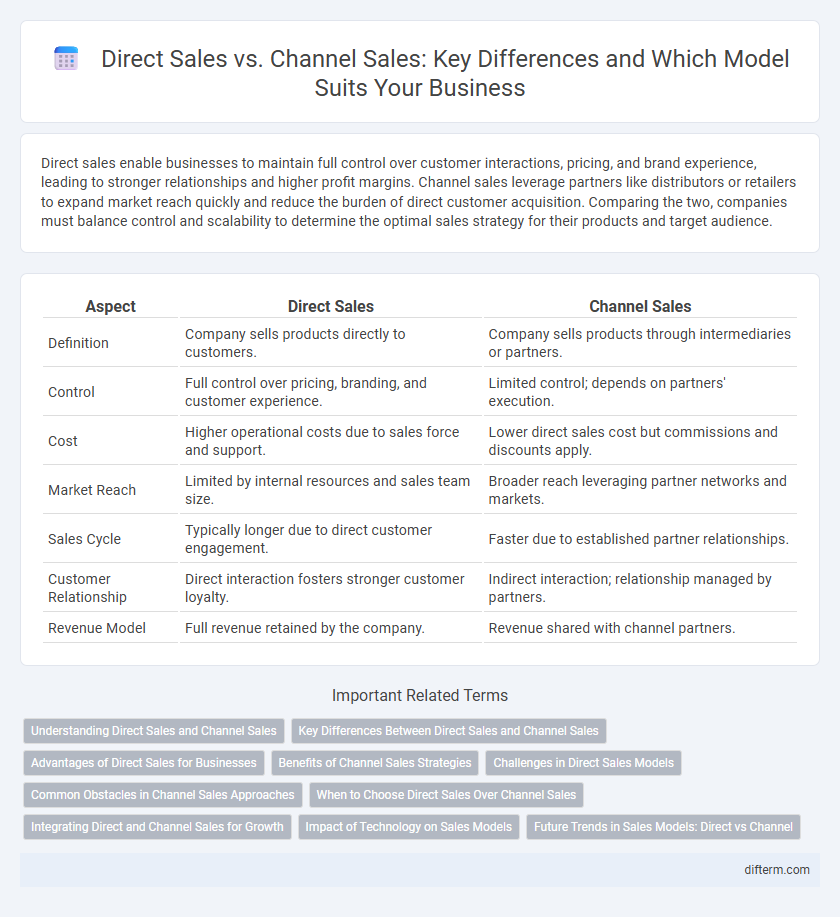Direct sales enable businesses to maintain full control over customer interactions, pricing, and brand experience, leading to stronger relationships and higher profit margins. Channel sales leverage partners like distributors or retailers to expand market reach quickly and reduce the burden of direct customer acquisition. Comparing the two, companies must balance control and scalability to determine the optimal sales strategy for their products and target audience.
Table of Comparison
| Aspect | Direct Sales | Channel Sales |
|---|---|---|
| Definition | Company sells products directly to customers. | Company sells products through intermediaries or partners. |
| Control | Full control over pricing, branding, and customer experience. | Limited control; depends on partners' execution. |
| Cost | Higher operational costs due to sales force and support. | Lower direct sales cost but commissions and discounts apply. |
| Market Reach | Limited by internal resources and sales team size. | Broader reach leveraging partner networks and markets. |
| Sales Cycle | Typically longer due to direct customer engagement. | Faster due to established partner relationships. |
| Customer Relationship | Direct interaction fosters stronger customer loyalty. | Indirect interaction; relationship managed by partners. |
| Revenue Model | Full revenue retained by the company. | Revenue shared with channel partners. |
Understanding Direct Sales and Channel Sales
Direct sales involve selling products or services straight from the manufacturer or provider to the end customer, enabling greater control over customer experience and higher profit margins. Channel sales rely on third-party intermediaries such as distributors, retailers, or agents to reach a broader market and leverage established networks for faster scalability. Understanding the strengths and challenges of direct sales versus channel sales helps businesses optimize distribution strategies for revenue growth and market penetration.
Key Differences Between Direct Sales and Channel Sales
Direct sales involve a company selling products or services straight to the end customer, enabling greater control over customer relationships and pricing strategies. Channel sales rely on intermediaries such as distributors, resellers, or agents to reach a broader market and leverage established networks. Key differences include control over the sales process, customer access, cost structure, and scalability potential.
Advantages of Direct Sales for Businesses
Direct sales offer businesses greater control over customer interactions and brand messaging, enabling personalized communication and tailored marketing strategies. This approach enhances profit margins by eliminating intermediaries, allowing companies to retain full revenue from each transaction. Direct sales also provide valuable customer data insights, facilitating improved product development and targeted promotional efforts.
Benefits of Channel Sales Strategies
Channel sales strategies expand market reach by leveraging established networks of distributors, retailers, or partners, enabling faster penetration into diverse geographic and demographic segments. This approach reduces costs associated with building and maintaining a direct sales force, allowing businesses to allocate resources towards product development and marketing. Enhanced scalability and localized expertise provided by channel partners improve customer engagement and increase overall sales efficiency.
Challenges in Direct Sales Models
Direct sales models face challenges such as higher customer acquisition costs and the need for extensive salesforce training to maintain product knowledge and customer engagement. Managing a direct sales team requires significant investment in recruitment, motivation, and retention to ensure consistent performance. Limited market reach compared to channel sales also hampers scalability and geographic expansion opportunities.
Common Obstacles in Channel Sales Approaches
Channel sales approaches often face common obstacles such as limited control over brand messaging and inconsistent customer experiences due to reliance on third-party partners. Conflicts of interest may arise when channel partners prioritize competing products, leading to reduced sales effectiveness. Managing complex communication and alignment between multiple stakeholders further complicates channel sales strategies.
When to Choose Direct Sales Over Channel Sales
Direct sales is ideal for businesses seeking full control over customer interactions, brand messaging, and pricing strategies, especially when targeting niche markets or launching new products. This approach fosters deeper customer relationships and faster feedback, critical for innovation-driven industries or high-value offerings. Direct sales suit companies aiming to maximize profit margins by eliminating intermediaries and adapting sales tactics quickly to market changes.
Integrating Direct and Channel Sales for Growth
Integrating direct sales and channel sales strategies enhances market reach and customer engagement by leveraging the strengths of both models. Direct sales offer personalized customer interactions and tailored solutions, while channel sales provide scalability and access to diverse markets through partnerships. Combining these approaches drives revenue growth, optimizes distribution, and creates a cohesive sales ecosystem adaptable to evolving business demands.
Impact of Technology on Sales Models
Technology has transformed direct sales by enabling personalized customer interactions through CRM systems and data analytics, driving increased conversion rates and customer loyalty. Channel sales benefit from digital platforms that facilitate partner collaboration, inventory management, and real-time market insights, enhancing efficiency and reach. Integration of AI-powered tools and automation streamlines both models, optimizing lead generation and sales forecast accuracy.
Future Trends in Sales Models: Direct vs Channel
Future trends in sales models indicate a growing emphasis on hybrid strategies that blend direct sales with channel sales to optimize market reach and customer engagement. Advances in AI-driven analytics and CRM platforms enable companies to personalize direct interactions while leveraging channel partners for broader distribution and localized expertise. Businesses adopting agile sales ecosystems combining direct and channel approaches are poised to enhance scalability, reduce costs, and improve customer retention in increasingly dynamic markets.
Direct Sales vs Channel Sales Infographic

 difterm.com
difterm.com